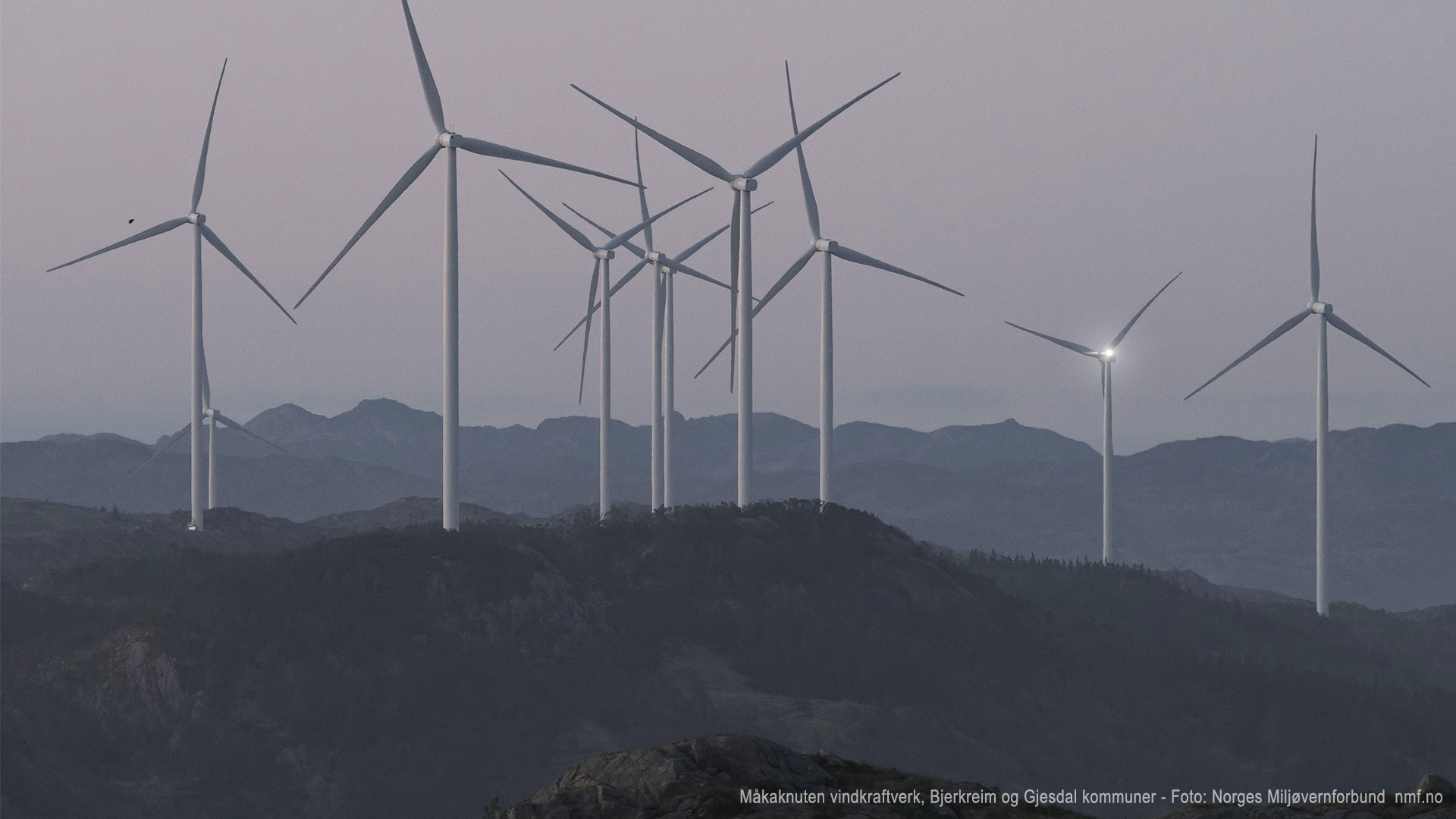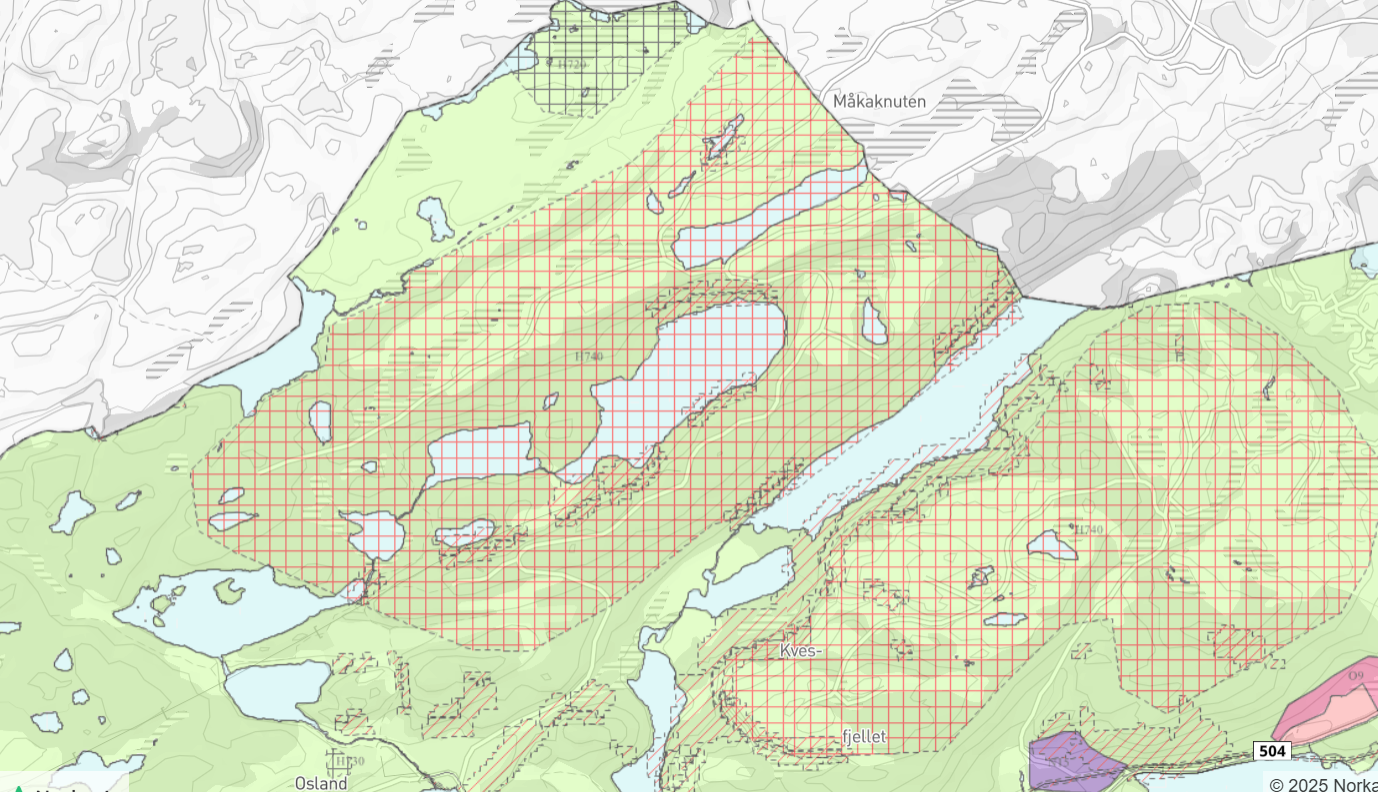Bjerkreim Municipality supports the Environmental Protection Association’s objection against Ewz’s attempted sneak maneuver in the Måkaknuten wind power plant.
Published 03.09.2025 Written by: Arnfinn Nilsen
The conflict over the Måkaknuten wind power plant is intensifying, and Bjerkreim Municipality is now opposing Ewz’s proposal for a new battery facility.

A decisive declaration of support
In its letter to NVE 01.09.2025 Bjerkreim municipality writes the following:
Furthermore, the municipality has received consultation input from the Norwegian Environmental Protection Association and the County Governor of Rogaland. At this point, the municipality supports the Environmental Protection Association’s comment that it is not appropriate for the battery facility to continue operating if the wind power plant’s license expires.
This is worth noting. In its clarification of the boundary between the Energy Act and the Planning and Building Act, Bjerkreim Municipality specifies that the area where the wind power plant is built is, under the current plan, designated as an LNF area (agriculture, nature, and outdoor recreation). This refutes Ewz’s claim that a new license here is unproblematic because, according to the developer, it is a “grey area.” The municipality points out in its introduction that this is an issue that must be clarified in relation to the applicable plan, and not in relation to the Energy Act for what extends beyond the set end date of the wind power plant’s license period.
This supportive statement is extremely important. Not only in relation to the comments the Environmental Protection Association raised regarding an entirely new 30-year license for the proposed battery solution in the middle of the wind power plant’s planning area, but it will also be relevant for other similar projects in an existing energy facility that has already begun the countdown of its remaining license period.
The Måkaknuten wind power plant in Bjerkreim and Gjesdal municipalities in Rogaland became one of the most controversial wind farms during the previous development round. Not only was it placed in an important and valuable natural area, but as many of you probably remember, they were allowed to increase both the capacity from 66 to 99 MW and the turbine height from 125 to 190 meters without the changes being put out for consultation. That was just how things were handled at NVE at the time.
Wants a battery facility that lasts longer than the license
The wind power plant was commissioned on 29.10.2020 and has a 25-year license lasting until 16.08.2045.
Now, five years into the license period, Ewz is applying for a 30-year license to install a large battery (two containers with a total capacity of 4,472 kWh) in the middle of the planning area. This means that both the battery and parts of the wind power plant’s infrastructure will remain for 10 years or more after the wind power plant’s license has expired.
The current licensing rules state that a wind power plant must be decommissioned and the landscape restored after the license expires. If they are now granted a new 30-year license for a battery facility in the middle of the wind power plant, which will remain long beyond the time when the wind power plant is supposed to be decommissioned and removed under current regulations, this appears to be a clear circumvention and evasion of the existing rules. This was also NMFs main objection in our consultation statement to NVE.
An important point is that such a battery solution, intended to stabilize the power supply, does not need to be placed inside a wind power plant. In practice, it can be located almost anywhere geographically where there is connection to the regional or supply grid. However, when an application seeks to place it within the planning area of a wind power plant that has less than 20 years remaining on its license period, and where it will remain for 10 years or more beyond the expiration date, this does not appear as a genuine effort to improve power supply stability for the benefit of society, but as an attempt to secure an unjustified and unauthorized advantage for oneself.
We are now also seeing much of the same pattern elsewhere in the country. At Buheii in Agder, there were recently plans to cover the ground between the wind turbines with vast areas of solar panels, but fortunately this has so far been stopped by the municipality. Far south in Rogaland, we find the Tellenes wind power plant, which was recently acquired by Eviny. In the middle of this wind farm is a “vacant section” where Norsk Vind wants to build yet another wind power plant, namely the Moldalsknuten wind power plant, which currently has a consultation on detailed regulation and planning program.
Eviny and Norsk Vind collaborate on licensing moves
The Tellenes wind power plant was commissioned on 26.08.2017, and the license expires on 26.08.2042. If a new 30-year license is granted in the middle of this wind farm, which will likely have only about 15 years left of its license period before it must be decommissioned and the landscape restored under current regulations, this will be a strong precedent for extending the license for Tellenes as well. This appears to be a coordinated maneuver between the license applicant Norsk Vind and the neighboring wind power company Eviny. bekreftes også i Europower News der det innrømmes at planen er at Eviny skal overta vindkraftverket når konsesjonen blir godkjent, mens driften fremdeles skal utføres av Norsk Vind. En grov tilsnikelse med andre ord.
This is precisely the strategy that NMF is now trying to challenge through our consultation statement on the proposed 30-year license for a battery solution at the Måkaknuten wind power plant.
In the letter from Bjerkreim Municipalituy to NVE dated 01.09.2025, the Municipality writes the following:
Bjerkreim Municipality has not found it necessary to submit consultation input on the license application for a battery facility at the Måkaknuten wind power plant. This is because we believe the measure must be clarified in relation to the current plan.
Ewz states that the relevant area is a “grey area,” but the municipality wishes to clarify that the current land-use designation in the municipal plan is LNF (agriculture, nature, and outdoor recreation):

EWZ has written the following about the relation to the planning and building laws:

The Municipality is questioning wether or not this assesment is correct
The planning and building laws set clear conditions for battery facilities
In legal literature (Planning and Building Act with commentary), the following is stated:
“The second paragraph represents a change compared to the legal situation under the Planning and Building Act (1985), in that ‘facilities for the transmission or conversion of electrical energy as mentioned in the Energy Act § 3-1, third paragraph’ are largely excluded from the scope of the Act, and that this includes ‘licensed facilities for the transmission or conversion of electrical energy with associated electrical equipment and building-technical structures according to the first paragraph.’ The exemption in PBL § 1-3 therefore applies to transmission facilities constructed under an individual facility license pursuant to the Energy Act. For further information, the municipality refers to the preparatory works related to the legislative amendment.”
In an interpretative statement from the ministry dated 02.03.2021 (ref. 21/790-3), the following is stated:
“Wind power plants are exempt from the requirement for zoning under the Planning and Building Act § 12-1, see the third paragraph, last sentence of the provision. In addition, wind power facilities shall not be subject to building case processing, cf. Planning and Building Act § 20-6 and SAK § 4-3, first paragraph, letter d. The other rules of the Planning and Building Act apply to wind power facilities.”
“Wind power plants, however, may not be constructed in violation of the current land-use plan. This follows from the Planning and Building Act § 1-6, second paragraph. The measure therefore requires that the relationship to the current land-use plans is either clarified through a dispensation, that the municipality already has a zoning plan where an area is designated for a wind power facility, or voluntarily prepares such a zoning plan.”
The same must apply to facilities intended to store the energy from the wind power plant…
The municipality’s assessment is that the facility may be exempt from the application requirement under the case processing regulations (SAK10 § 4-3), but that in any case, there is a requirement for plan clarification/dispensation from the current land-use designation regarding the battery storage. A dispensation application requires a new consultation with national and regional authorities.
Furthermore, the municipality has received consultation input from the Norwegian Environmental Protection Association and the County Governor of Rogaland. At this time, the municipality supports the Environmental Protection Association’s comment that it is not appropriate for the battery facility to continue operating if the license for the wind power plant expires. The requirement would then be that the terrain be restored, and the battery storage could delay such a process. It cannot therefore be expected that the municipality would wish to grant a dispensation beyond the current license period. A new dispensation may be applied for if the licenses for the wind power plant are extended.

